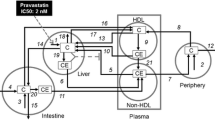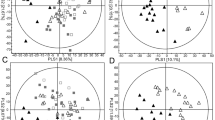Abstract
Lovastatin, widely used to lower cholesterol, is a pro-drug that requires metabolic activation through hydrolysis by carboxyesterases. There appear to be at least three distinct esterases in humans capable of catalysing this reaction, one in plasma and two in the liver.
The rate of lovastatin hydroxy acid formation was measured as 15.8 pmol · ml−1 · min−1 in plasma, 2.13 pmol · mg−1 protein · min−1 in hepatic microsomes and 0.92 pmol · mg−1 protein · min−1 in cytosol. The data suggest that on average the three esterases together are capable of activating about 220 nmol (90 μg) lovastatin per minute per person, to which the esterases of plasma, liver microsomes and liver cytosol contribute approximately 18, 15 and 67%, respectively.
All three esterases showed evidence of inter-individual variability. In one of 17 livers, both cytosolic and microsomal esterase activity was completely missing, while two other liver specimens lacked one esterase.
Such variability must be expected to influence the therapeutic efficacy of the drug, and they might be related to its occasional toxicity.
Similar content being viewed by others
References
Endo A (1992) The discovery and development of HMG-CoA reductase inhibitors. J Lipid Res 33: 1569–1582
Tobert JA, Bell JD, Birtwell J, et al (1982) Cholesterol-lowering effect of mevinolin, an inhibitor of 3-hydroxy-3-methylglutaryl-Coenzyme A reductase, in healthy volunteers. J Clin Invest 69: 913–919
Frishman WH, Zimetbaum P, Derman M (1992) HMG-CoA reductase inhibitors. In: Frishman WH (ed) Medical management of lipid disorders — Focus on prevention of coronary artery disease. Futura, Mount Kisco, NY, pp 153–180
Duggan DE, Chen I-W, Bayne WF, et al (1989) The physiological disposition of lovastatin. Drug Metab Disposit 17: 166–173
Stubbs RJ, Schwartz M, Bayne WF (1986) Determination of mevinolin and mevinolinic acid in plasma and bile by reversed-phase high-performance liquid chromatography. J Chromatogr 383: 438–443
Campbell ME, Grant DM, Inaba T, Kalow W (1987) Biotransformation of caffeine, paraxanthine, theophylline, and theobromine by polycyclic aromatic hydrocarbon-inducible cytochrome(s) P-450 in human liver microsomes. Drug Metab Disposit 15: 237–249
Kalow W, Bertilsson L (1994) Interethnic factors affecting drug response. Adv Drug Res 25: 1–53
Eiberg H, Mohr J (1986) Identity of the polymorphisms for esterase D and S-formylglutathione hydrolase in red blood cells. Hum Genet 74: 174–175
Verpoorte JA, Mehta S, Edsall JT (1967) Esterase activities of human carbonic anhydrases B and C. J Biol Chem 242: 4221–4229
Author information
Authors and Affiliations
Rights and permissions
About this article
Cite this article
Tang, BK., Kalow, W. Variable activation of lovastatin by hydrolytic enzymes in human plasma and liver. Eur J Clin Pharmacol 47, 449–451 (1995). https://doi.org/10.1007/BF00196860
Received:
Accepted:
Issue Date:
DOI: https://doi.org/10.1007/BF00196860




